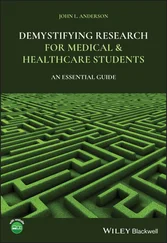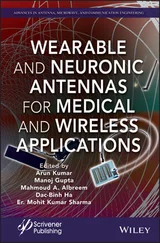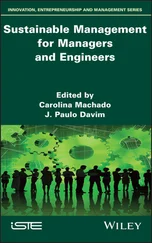Alvaro Meseguer - Fundamentals of Numerical Mathematics for Physicists and Engineers
Здесь есть возможность читать онлайн «Alvaro Meseguer - Fundamentals of Numerical Mathematics for Physicists and Engineers» — ознакомительный отрывок электронной книги совершенно бесплатно, а после прочтения отрывка купить полную версию. В некоторых случаях можно слушать аудио, скачать через торрент в формате fb2 и присутствует краткое содержание. Жанр: unrecognised, на английском языке. Описание произведения, (предисловие) а так же отзывы посетителей доступны на портале библиотеки ЛибКат.
- Название:Fundamentals of Numerical Mathematics for Physicists and Engineers
- Автор:
- Жанр:
- Год:неизвестен
- ISBN:нет данных
- Рейтинг книги:5 / 5. Голосов: 1
-
Избранное:Добавить в избранное
- Отзывы:
-
Ваша оценка:
Fundamentals of Numerical Mathematics for Physicists and Engineers: краткое содержание, описание и аннотация
Предлагаем к чтению аннотацию, описание, краткое содержание или предисловие (зависит от того, что написал сам автор книги «Fundamentals of Numerical Mathematics for Physicists and Engineers»). Если вы не нашли необходимую информацию о книге — напишите в комментариях, мы постараемся отыскать её.
Fundamentals of Numerical Mathematics for Physicists and
Engineers
Provides a modern perspective of numerical mathematics by introducing top-notch techniques currently used by numerical analysts Contains two parts, each of which has been designed as a one-semester course Includes computational practicals in Matlab (with solutions) at the end of each section for the instructor to monitor the student's progress through potential exams or short projects Contains problem and exercise sets (also with solutions) at the end of each section is an excellent book for advanced undergraduate or graduate students in physics, mathematics, or engineering. It will also benefit students in other scientific fields in which numerical methods may be required such as chemistry or biology.
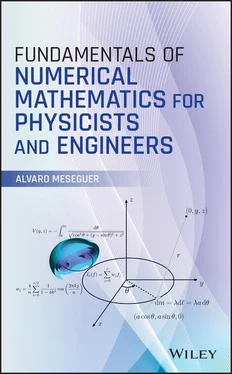
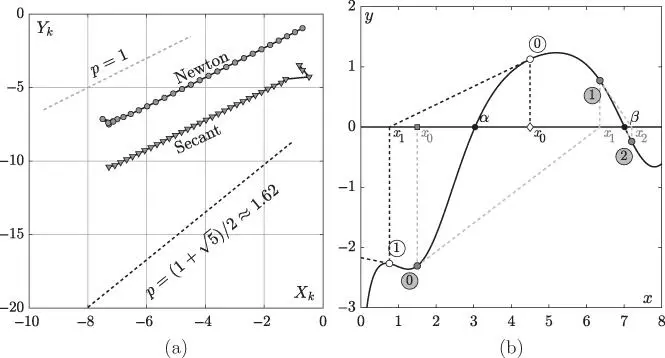
 of equation
of equation  . The
. The  ordinates corresponding to the secant method (triangles) have been shifted downwards three units to avoid overlap between the two sets of data and help visualize. (b) Newton's method iterates for the solution of
ordinates corresponding to the secant method (triangles) have been shifted downwards three units to avoid overlap between the two sets of data and help visualize. (b) Newton's method iterates for the solution of  .
. of the equation
of the equation  studied in Section 1.6. Newton's iteration is started from
studied in Section 1.6. Newton's iteration is started from  , whereas the secant has been initialized from the interval
, whereas the secant has been initialized from the interval  that contains the root. The reader may check that in this case Newton's and secant methods lose their quadratic and golden ratio orders, respectively, both exhibiting linear convergence, as shown in Figure 1.4a. Double or ill‐conditioned roots appear in physics more frequently than one may expect, particularly in problems where the transcendental equation to be solved is the result of imposing some kind of critical or threshold condition (we refer the reader to Practical 1.2, for example).
that contains the root. The reader may check that in this case Newton's and secant methods lose their quadratic and golden ratio orders, respectively, both exhibiting linear convergence, as shown in Figure 1.4a. Double or ill‐conditioned roots appear in physics more frequently than one may expect, particularly in problems where the transcendental equation to be solved is the result of imposing some kind of critical or threshold condition (we refer the reader to Practical 1.2, for example). is really close to the sought root, i.e. most of the methods are just locally convergent . In practice, a root‐finding algorithm starting from an initial guess
is really close to the sought root, i.e. most of the methods are just locally convergent . In practice, a root‐finding algorithm starting from an initial guess  moderately far away from the root could easily lead to a sequence
moderately far away from the root could easily lead to a sequence  that may wander from one point to another of the real axis, eventually diverging to infinity or converging to a solution (not necessarily the sought one). Figure 1.4b illustrates this phenomenon by showing the result of computing the roots of the function
that may wander from one point to another of the real axis, eventually diverging to infinity or converging to a solution (not necessarily the sought one). Figure 1.4b illustrates this phenomenon by showing the result of computing the roots of the function  using Newton's method starting from different initial guesses. The first two roots of
using Newton's method starting from different initial guesses. The first two roots of  are located at
are located at  and
and  (black bullets in Figure 1.4b). In this example, we initialize Newton's method from two initial guesses reasonably close (but not too close) to
(black bullets in Figure 1.4b). In this example, we initialize Newton's method from two initial guesses reasonably close (but not too close) to  . To guide the eye, we have indicated the history of each of the two sequences by encircled numbering of their ordinates. The first sequence starts at
. To guide the eye, we have indicated the history of each of the two sequences by encircled numbering of their ordinates. The first sequence starts at  (gray square) and Newton's first iterate
(gray square) and Newton's first iterate  is already very close to
is already very close to  , to which the sequence eventually converges (gray dashed lines and symbols). The second sequence starts from
, to which the sequence eventually converges (gray dashed lines and symbols). The second sequence starts from  (white diamond), unfortunately leading to a location
(white diamond), unfortunately leading to a location  where Newton's algorithm predicts a negative second iterate
where Newton's algorithm predicts a negative second iterate  , which is not even within the function's domain due to the logarithmic term.
, which is not even within the function's domain due to the logarithmic term. is usually impossible. In the first case, we may have naturally expected the sequence to approach
is usually impossible. In the first case, we may have naturally expected the sequence to approach  instead of
instead of  (because of its initial proximity to the former one). In the second case, we could have also naturally expected the sequence to converge at least to either one of the two roots, but never such a dramatic failure of the iteration. We recommend the reader to explore the complex convergence properties of Newton's method by starting the iteration from a wide range of initial guesses located between
(because of its initial proximity to the former one). In the second case, we could have also naturally expected the sequence to converge at least to either one of the two roots, but never such a dramatic failure of the iteration. We recommend the reader to explore the complex convergence properties of Newton's method by starting the iteration from a wide range of initial guesses located between  and
and  . The reader may also repeat the experiment with the secant or chord algorithms to conclude that the behavior of the sequences is also unpredictable when using these methods.
. The reader may also repeat the experiment with the secant or chord algorithms to conclude that the behavior of the sequences is also unpredictable when using these methods. with a unique root
with a unique root  in the open interval
in the open interval  , a root‐finding method is said to be globally convergent within
, a root‐finding method is said to be globally convergent within  if
if  for all initial guesses
for all initial guesses  . The bisection method or the Regula Falsi 12 method are examples of globally convergent algorithms. However, these and other univariate globally convergent methods are not always easily adaptable to solve systems of nonlinear equations.
. The bisection method or the Regula Falsi 12 method are examples of globally convergent algorithms. However, these and other univariate globally convergent methods are not always easily adaptable to solve systems of nonlinear equations.
